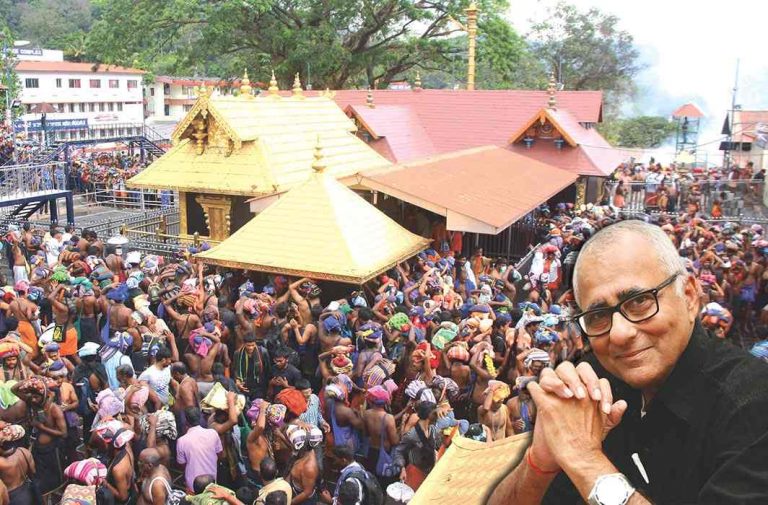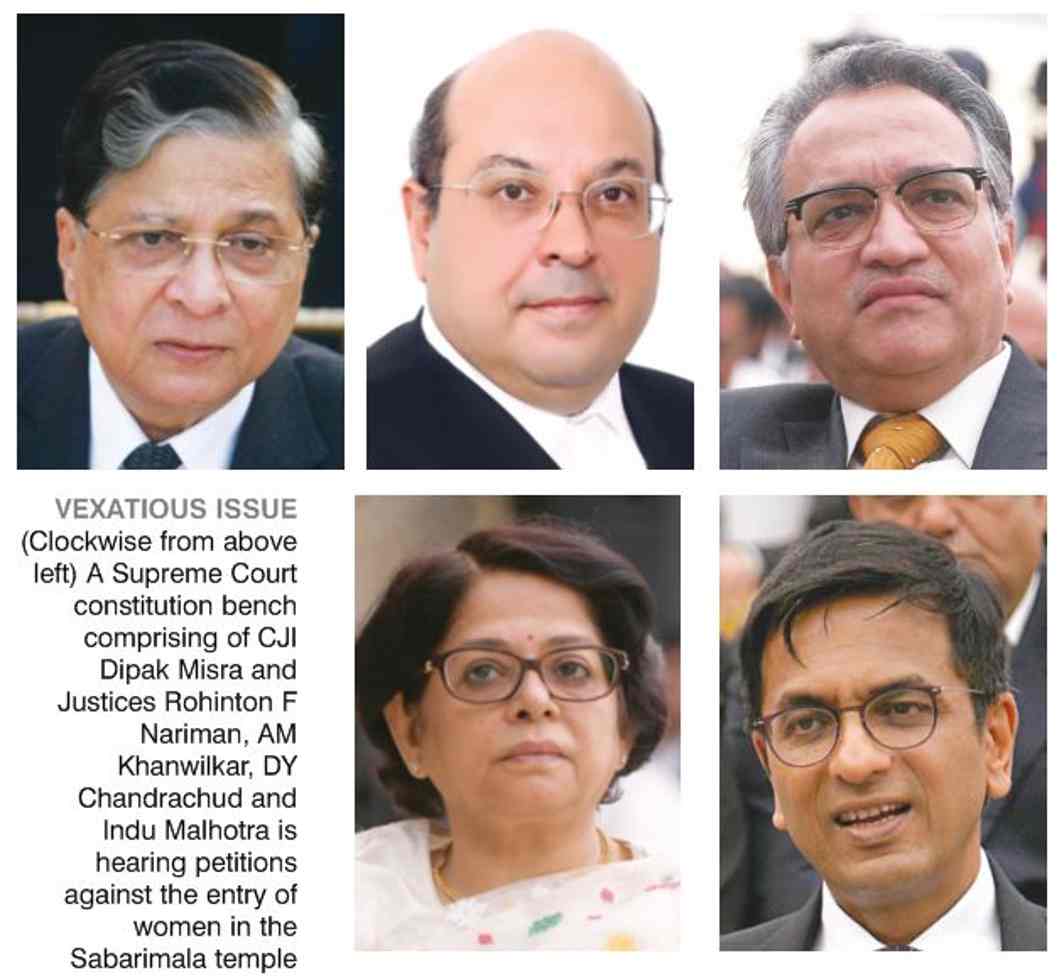
Above: The Sabarimala Temple board has argued in the SC that the state is permitted to interfere in the religious matters of its people but only on limited grounds
~By Inderjit Badhwar
Several years ago while dwelling on the subject of the Himachal Pradesh High Court’s order banning the ritual Hindu sacrifice of animals, I wrote that judges often have to rush in where angels have feared to tread. Especially in dealing with matters of immense social, religious, ethnic, cultural sensitivity. When legislators and administrators, fearing a popular backlash, a violent repercussion or a political recoil, back off from making tough decisions or enacting laws that will be politically unpopular, the courts have the obligation to step in to advance society’s movement towards achieving goals which the march of civilization has come to accept as self-evident, universal truths—kindness, fair play, equal rights, the right to liberty and the pursuit of happiness.
These ethical compulsions, our cultural evolution as a species—propelled by religious and spiritual doctrines, revelations, philosophical treatises, reasoned discourse, the voices of peripatetic preachers—mark what is often referred to as the Ascent of Man. It is an obstacle course in which the impediments—religious sanction, superstition, bigotry, racial rage, violent conquest—are removed, sometimes by the terrible weapons of war, sometimes by non-violent, passive resistance, preachers, movements, the ballot, legislation, the courts. And we move on.
The Indian Supreme Court has already ruled on sensitive cases such as Shah Bano (a Muslim woman’s right to alimony following a divorce) in the mid-1980s, and more recently Triple Talaq— both of which impacted the lives of women and had the more conservative elements of the Muslim clergy up in arms against what they consider state intrusion into religious matters.
Today, the Supreme Court is seized of another vexatious issue—the right of Hindu women to enter halls of worship—in particular, the Sabarimala temple in Kerala. A similar controversy erupted in August 2016 when the High Court in Mumbai ruled that banning women from the sanctum sanctorum of the 15th century Sufi Haji Ali shrine “violated the constitution” and was discriminatory towards women. The shrine trust challenged the ruling in the Supreme Court but later agreed to rescind the ban.
The entry of socially active rights groups as well as the courts into what were hitherto considered forbidden religious terrain has once again raised the seminal issue of whether India is heading—or can, indeed, head—into a new era of encoding a Uniform Civil Code (UCC). This has been the subject of endless controversies starting with the debates in the Constituent Assembly. Different ideologies have propagated its necessity as the ultimate ideal of a secular democracy in which no religious group or entity should have the right to violate the code. One country, one code, the proponents argue, but the opinions start becoming anodyne when they realize that this precept could be a double-edged sword. It becomes a question of whose ox is being gored.

Dr BR Ambedkar, the father of the Indian Constitution, personally favoured a uniform code but realized how difficult it may be to implement on the ground. As a compromise, Article 44 was added to Constitution as a Directive Principle of State Policy. The nascent Indian state would make its achievement an objective rather than casting laws in stone. As a commentator in LexisNexis explains: As distinct in their scope and character from public laws that govern the relation between individuals and the state, the private laws or the personal laws concern the relations amongst individuals and private entities in a society. On the face of it, “voicing for a Uniform Civil Code as done by Shah Bano, it was realised as to how a Uniform Civil Code was much big a battle in politics than in law. And politics in India is about people. Thus, it now seems to me, that unless all stakeholders come to the same page on this, any attempt to bring on a Uniform Civil Code would be an attempt at futility”.
The commentary adds that while not all Muslims (or other religious minorities) are opposed to a common civil code, they express trepidation from several quarters. Any need put forth for a Uniform Civil Code must also be seen in the light of its potential efficacy. “The first question would be whether it is possible to reconcile the differences within the Indian society to come up with a code that could be acceptable to all religious communities residing within India. A comparison of the personal laws of Hindus, Muslims and other communities will expose the sheer and stark diversity of these laws.”
The entry of socially active rights groups and courts into what were hitherto considered forbidden religious terrain has once again raised the seminal issue of whether India is heading—or can, indeed, head—into a new era of encoding a Uniform Civil Code. This has been the subject of endless controversies.
As Dr Faizan Mustafa, Vice-Chancellor, NALSAR, states: “Between uniformity and legal pluralism, the latter is a superior value. History contains many instances of pluralistic legal systems in which multiple sources of law existed. Even in the states of Goa and of Jammu and Kashmir, there are no uniform provisions governing the personal domains of marriage and divorce. Thus, pluralism in legal sources and rules is inevitable, especially in a multicultural democratic republic like India.”
This, indeed, is the primary argument used by the Sabarimala board in defense of its right to disbar women from the temple. Their main crutch is Article 25 of the Constitution under which people have a right to practice their religious beliefs and propagate their faith so long as no coercion is involved. The state is permitted to interfere in the religious matters of its peoples on very limited grounds.
Proponents of the continued ban on women argue that discontinuance of this practice through a Court edict would open a “Pandora’s Box”. They told the five-judge Constitution bench headed by Chief Justice Dipak Misra that the test of constitutional morality cannot be applied to old religious practices. “All mosques, except those of Dawoodi Bohra Muslim sect, do not allow women inside… It will open the pandora’s box. There are several religions and several practices, and millions of faiths and beliefs and they may not pass the constitutional morality test.
“My belief may be fickle, irrational. There are sects of Shias who believe in self-flagellation. Many will call it barbaric, others will say it is religious. It is certainly not in consonance with 2018 notions, but it is still my belief.”
Most sensible laws emanate from an unwritten concept called natural justice. This does not mean an eye-for-an-eye retributive jurisprudence but rather the evolution of ethical, just, humane and fair behaviour which all religions ostensibly espouse. In this sense, just as freedom of speech and expression under Article 19 cannot be completely unfettered, freedom of religion, as it translates into personal law, under Article 25, cannot be absolute or we would be glorifying retrograde practices like Sati or Triple Talaq, and at the extreme end, the burning of heretics and witches. Nor can Article 25 be allowed to take precedence over the basic structure of the Constitution as exemplified by Article 21 guaranteeing the right to life, liberty, livelihood as well as freedom from discrimination.
What needs careful calibration is whether the denial of women into Sabarimala, proposing (as the recent National Commission on Women has done) a ban on women’s confessions in Church, the long-standing Parsi ritual of confining their dead to the Tower of Silence, marriage of Catholic priests, entry of nuns into the priesthood and related proscriptions deprive the victims of the right to livelihood, the right to worship, the right to equal opportunity, the right to equal justice.
It is a politico-legal minefield because of the social and political tensions involved. Yet, the Indian courts have dared to navigate it while simultaneously getting drawn into any open proclamation of supporting a Uniform Civil Code. The Himachal High Court walked this tightrope with rare legal dexterity in its landmark judgment banning animal sacrifice as a display not of religion but of unbridled cruelty. Its proponents had argued endlessly about the right to religious practices guaranteed under Article 25.
In that judgment, India took a great step in moving on when Justices Rajiv Sharma and Sureshwar Thakur gaveled a new prohibition: The High Court banned the sacrifice of animals in temples, saying they “cannot be permitted to be killed in a barbaric manner to appease Gods”.
“Religion, therefore, be construed in the context of Articles 25 and 26 in its strict and etymological sense. Every religion must believe in a conscience and ethical and moral precepts…. There is nothing which a man can do, whether in the way of wearing clothes or food or drink, which is not considered a religious activity. Every mundane or human activity was not intended to be protected by the constitution under the guise of religion.
“The approach to construe the protection of religion or matters of religion or religious practices guaranteed by Articles 25 and 26 must be viewed with pragmatism since by the very nature of things, it would be extremely difficult, if not impossible, to define the expression religion of matters or religion or religious belief or practice. The religious freedom guaranteed by Articles 25 and 26, therefore, is intended to be a guide to a community-life and ordain every religion to act according to its cultural and social demands to establish an egalitarian social order. Articles 25 and 26, therefore, strike a balance between the rigidity of right to religious belief and faith and their intrinsic restrictions in matters of religion, religious beliefs and religious practices and guaranteed freedom of conscience to commune with his Cosmos, Creator and realize his spiritual self.”
They added: “The rituals attached to animal sacrifice reflect only cruelty, superstition, fear and barbarism and have nothing to do with either religion or culture. Practices like Sati, female feticide, child marriage, untouchability, etc., were continuing since generations and were deeply ingrained in the social milieu, but have been almost eradicated with the education and reformation movements as well as judicial intervention.”
Just as freedom of speech and expression under Article 19 can’t be completely unfettered, freedom of religion, as it translates into personal law, under Article 25 cannot be absolute or we would be glorifying retrograde practices like Sati or Triple Talaq and the burning of heretics and witches.
What was truly courageous and luminous about this nearly 200-page judgment is its unflinching upholding of human and humane values above every counter-argument based on freedom of religion and worship, the right to eat meat, religious personal laws, ritualistic non-vegetarianism, ancient traditions, scriptural edicts, verses from religious texts and international cases. With the wisdom of a Daniel come to judgment, the judges took the arguments of their detractors head-on with scholarly research, matching argument for argument, separating fact from fiction, myth and superstition from reality and common sense, and argued their case for moral core values that are essential spiritual beacons to guide a nation and a people into the radiance of knowledge.
Readers of this column would do well to read this judgment (High Court of Himachal Pradesh, CWP No. 9257 of 2011 along with CWP No.4499/2012 and CWP No.5076/2012) in full, not only because of the light it sheds on religion and religious practices, but also because it is a transformative experience.


inconclusive article on UCC
Comments are closed.